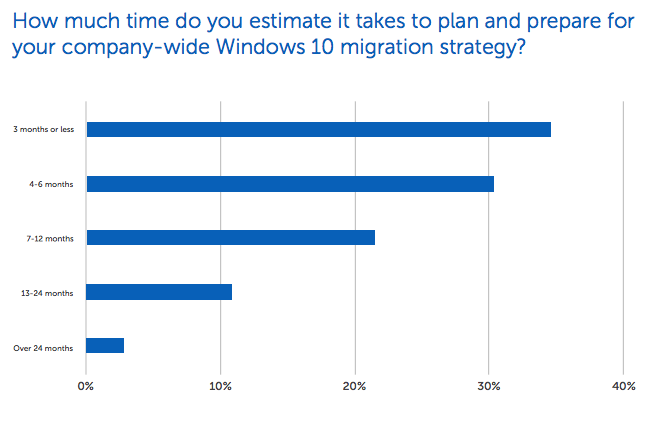Despite lengthy planning cycles, enterprises may have reached a tipping point in their migration to Windows 10. This comes from Adaptiva’s latest survey on Windows 10 enterprise impact, which also revealed a significant number of IT leaders expect to leverage automation tools to migrate all systems to Windows 10.
This year’s survey found that 99 percent of the 446 respondents plan to migrate to Windows 10, and nearly 53 percent have already migrated more than 10 percent of theirs systems to Windows 10. And 28 percent of the respondents said that they are more than halfway through their migrations, and the number is expected to climb to 52 percent by this time next year, according to the survey.
“The enterprise now appears to be embracing Windows 10 more aggressively than we would have expected from last year’s results,” said Jim Souders, chief executive officer at Adaptiva. “It’s taken IT leaders a bit longer to get to this point than most industry experts anticipated a year or two ago, but now they’re finding that once they’ve completed their lengthy planning cycle and decided on their automation solutions, they can move rather quickly.”
While many companies are making the move to Windows 10, there is still much planning and preparation to complete before they can begin an organization-wide migration.
Nearly 35 percent of respondents expect to complete their migration planning in less than three months, according to the survey, but more than half of the respondents estimate that it will be four to 12 months, with 14 percent saying it will take even longer.

Time is one of the biggest challenges organizations face when it comes to migration to Windows 10, which is a first compared to previous years. Time is on the minds of IT leaders primarily because of how long they need to spend on each system to be migrated.
For instance, 57 percent of respondents expect migration to take between two and four hours per system, where 13 percent of respondents expect the migration to Windows 10 to take a day or more per system.
This may suggest that organizations expect to deploy large IT teams to migrate these machines, but 49 percent of respondents say they expect to complete their entire migration efforts with a team of five or fewer IT members.
“IT leaders are discovering that there’s more that can be automated than they expected, and that makes it easier to enable a small team of people to accomplish Windows 10 deployment tasks in a short amount of time,” the company said in a statement.






